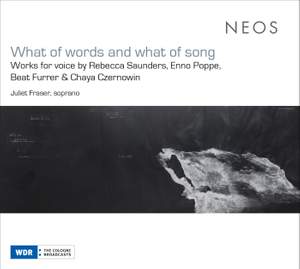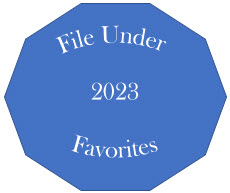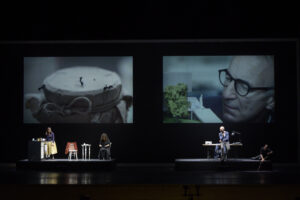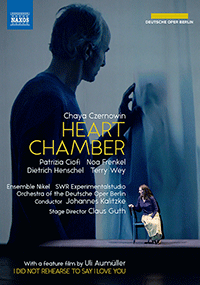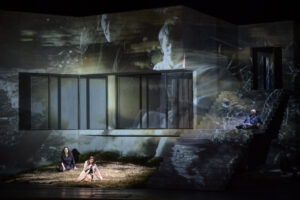What of Words and What of Song
Juliet Fraser, vocalist
With Mikael Rudolfsson, trombone, Helen Bledsoe, bass flute, and Uli Fussenegger, double bass
NEOS Music
Soprano Juliet Fraser is one of very few performers who could successfully present the challenging program on What of Words and What of Song (NEOS Music). It consists of works by European composers born in the 1950s and 1960s: Rebecca Saunders, Enno Poppe, Beat Furrer, and Chaya Chernowin. Fraser doesn’t just sing them, she inhabits the pieces with encompassing dramatic commitment.
“O,” by Rebecca Saunders, features swooping glissandos and breath slides, alongside untexted sections that not only include vowels, but lip and throat trills, gasps, quick-rendered gibberish, overtones, and throat singing. Fraser makes these seemingly incongruous elements cohere into an expressive presentation that imparts a dramatic shape despite lacking a perceptible text. It ends with an ascending glissando that suggests a question mark. O Yes and I, also by Saunders, is a successor to O, in which its material is repurposed for a duet with bass flute, here played by Helen Bledsoe. Bledsoe is a worthy collaborator, mimicking Fraser and alternatively serving as a foil. She also has impressive control with the instrument, playing securely in a wide dynamic range with stentorian attacks that can be challenging on this large member of the flute family.
Enno Poppe’s Wespe (“Wasp”) uses undulating pitches to describe the insect’s path. Gradually, consonants are added and additional motives suggest a wasp lighting from place to place, occasionally buffeted by the wind. It is subtle in its programmatic use of vocalise, but the result is beguiling
Trombonist Mikael Rudolfsson joins Fraser for Spazio Immergente I (“Immersive Space”) by Beat Furrer. Muted trombone lines swoop around swelling high notes from Fraser. The soprano then sings repetitions that mirror the gestures in the trombone. The mute comes off, and there is a more competitive stance between the performers and a role reversal, the trombone undertaking swells while Fraser performs digressive riffs. Eventually, the two are joined in performing long glissandos, Fraser arriving at some of her highest notes as Rudolfsson then undertakes low pedal tones. A coda replete with staccato culminates with a flurry of fortissimo attacks in altissimo gestures from Fraser and glissandos and blats in the bass from Rudolfsson.
Adiantum Capillus-Veneris I (“Maidenhair fern”) is by Chaya Czernowin. Maidenhair ferns are distinctive in their ability to shed rainwater without getting wet. The ferns grow in many places in the world, including Israel, where Czernowin is from and first saw them. The piece is marked,”for voice and air.” The use of exaggerated inhalations and exhalations serves as an extra “voice.” There is a watery ascent of breath at the beginning that is then replaced with sung ascending glissandos, each with pauses for breath. The rate of change gradually speeds up, followed by whooshes and ha’s. Then blowing outward between silences. The watery ascent continues, held at the end each time in emphatic fry. A long breath serves as a transition to the voice’s return to singing ascending glissandos; the two are then juxtaposed. Descending minor thirds add a final motive to the mix. The opening ascent and fry return, and the piece closes in whorls of air. Czernowin has likened Adiantum Capillus-Veneris I to a line drawing or small painting; this is an excellent analogy for the deployment of its detailed material.
The last piece on the recording is Lótofagos I (lotus-eaters) for soprano and double bass by Beat Furrer. Fraser’s collaborator here is Uli Fusseneger, who is a stellar player. Lotus-eaters are people from an episode in Homer’s Odyssey who ate only lotuses, which caused them to forget. Today, the term connotes an indolent pleasure-seeker. The texts, for here words are recognizably employed, are by José Ángel Valente. It is a strange story, rendered with a gradual buildup from cooing to fortissimo keening, and softly rendered tight dissonances and double-stops to full chords on the double-bass. Furrer’s take appears to embody the fear of loss of recognition rather than a sense of peaceful rest. Little shared motives seem to dissolve over the course of the piece; another framing of forgetting, here as oblivion. As the piece goes on, language is lost in places to lip trills and isolated vowels, with the poem seeming to dissolve too.
The four composers here are imaginative in their conceptions of vocalism beyond language. Fraser embodies each of their pieces compellingly, with impressive attention to details of vocal, musical, and expressive elements. What of Words and What of Song is one of my favorite releases I have encountered in 2023.
-Christian Carey
